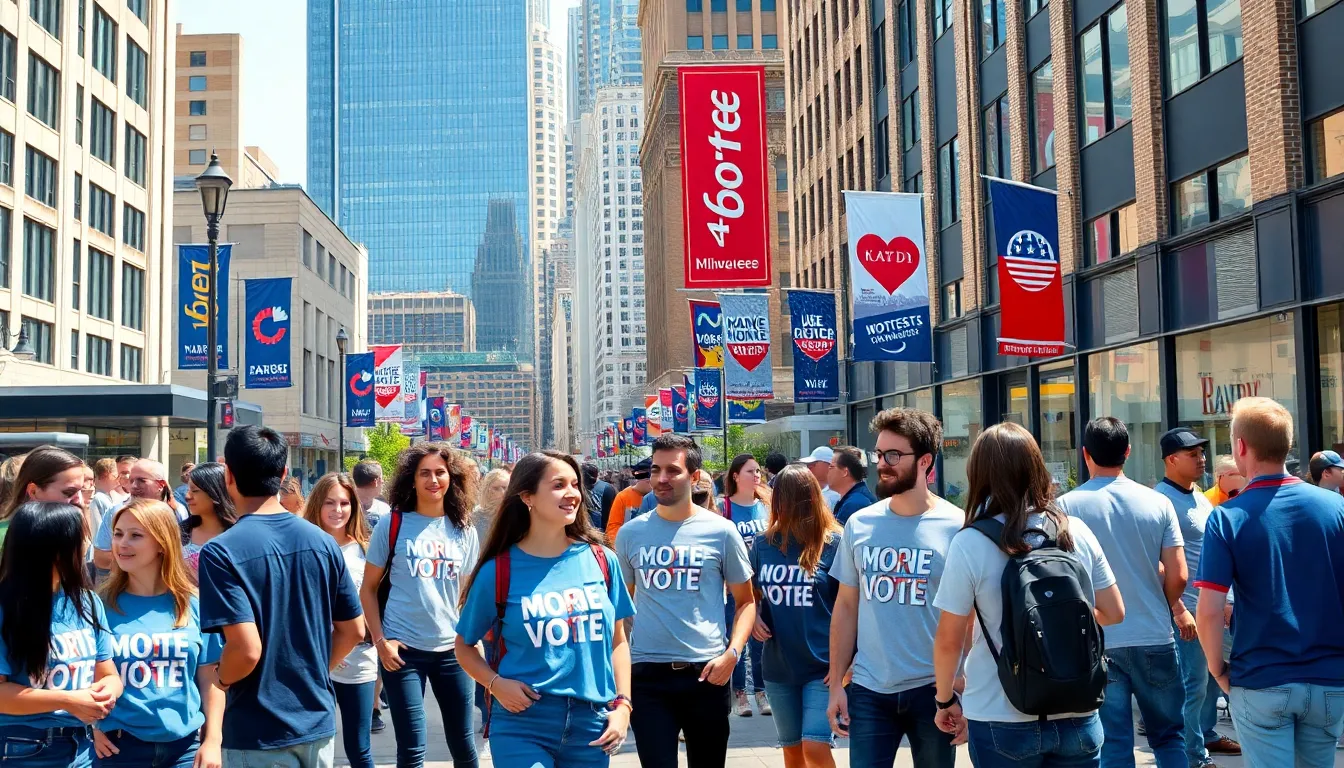When it comes to politics, Wisconsin’s like that unpredictable cheese curd—sometimes it’s squeaky and other times it’s just plain soft. Is it a blue state? The answer might surprise you. With its rich history of political battles, this Midwestern gem has swung between red and blue faster than a Packer fan can chug a beer on game day.
In recent elections, Wisconsin has found itself at the center of heated debates and nail-biting results. As voters navigate the complexities of local and national issues, the question remains: is Wisconsin leaning toward the Democratic side or holding tight to its Republican roots? Buckle up as we dive into the political landscape of the Badger State and uncover the truth behind its vibrant electoral identity.
Table of Contents
ToggleOverview of Wisconsin’s Political Landscape
Wisconsin’s political climate exhibits significant variability, reflecting its historical transitions between party dominance. Voter turnout has shown dramatic shifts in presidential elections, with the state flipping between Democratic and Republican candidates. In 2020, Joe Biden secured Wisconsin with 49.4% of the vote, while Donald Trump garnered 48.8%. This narrow margin underscores the competitive nature of recent elections.
Demographics play a crucial role in shaping electoral outcomes. Urban areas like Milwaukee and Madison lean heavily Democratic, while rural regions tend to support Republican candidates. The segregation of urban and rural voting patterns creates a unique electoral dynamic that influences statewide elections.
Key issues often sway voters. Economic policies, healthcare, and education significantly impact electoral decisions. In recent years, the focus on issues such as unemployment rates and public health has heightened voter engagement, leading to higher turnout rates among young voters and underrepresented communities.
Party identification has evolved. In 2016, Wisconsin’s historical reputation as a swing state became pronounced, as it voted for Trump after leaning Democratic in the previous presidential election. This trend persisted, contributing to speculation about the state’s electoral future.
Gubernatorial races add another dimension. Incumbent Governor Tony Evers, a Democrat, won election in 2018, defeating Republican Scott Walker. The ongoing rivalry between state parties continues to shape legislative agendas and influence campaign strategies.
Wisconsin’s political identification remains fluid, reflecting a blend of Democratic and Republican influences. Continued analysis reveals how both parties adapt to the changing landscape, addressing constituents’ needs and responding to emerging issues.
Historical Voting Trends

Wisconsin’s voting history reveals a complex pattern of political preferences that oscillate between Democratic and Republican candidates. This unpredictability adds depth to the state’s electoral identity.
Key Elections and Outcomes
In 2016, Donald Trump claimed victory in Wisconsin, marking the first time a Republican presidential candidate won the state since 1984. His margin of victory was just 22,748 votes. Conversely, Joe Biden flipped the state back to Democratic in 2020, garnering 49.4% of the vote compared to Trump’s 48.8%. The close outcomes of these elections underscore Wisconsin’s role as a crucial battleground. Other key elections, such as the 2018 gubernatorial race, also highlight the competitive nature of the state’s political landscape; Tony Evers defeated Scott Walker, further signaling shifting voter allegiances.
Major Political Shifts
Political shifts in Wisconsin often stem from demographics and emerging issues. Urban populations, particularly in cities like Milwaukee and Madison, increasingly lean Democratic. Meanwhile, rural voters typically align with Republican values. Changing voter concerns significantly influence these shifts. For instance, issues related to healthcare and education have prompted younger voters and diverse communities to engage more actively in politics. Since 2010, the state has experienced a clear trend towards partisan polarization, with both parties striving to adapt their platforms to resonate with ever-evolving voter priorities.
Current Political Climate
Wisconsin’s political climate continues to evolve, showcasing a complex blend of influences from both major parties.
Democratic Influence
Democrats hold sway particularly in urban centers. Milwaukee and Madison consistently produce high voter turnout for Democratic candidates. Young voters and diverse communities play a crucial role in this trend, advocating for progressive issues including healthcare and education reform. The narrow victory of Joe Biden in 2020, with 49.4% of the vote, underscores this Democratic strength amidst a competitive landscape. Various grassroots movements amplify Democratic agendas, focusing on social justice and environmental policies. The party’s growing appeal reflects a strategic response to shifting demographics and the priorities of younger voters.
Republican Presence
Republicans maintain a solid foothold across Wisconsin’s rural areas. Their voter base often prioritizes traditional values and economic conservatism. Notably, Donald Trump’s 2016 victory highlighted the party’s relevance, winning the state by just 22,748 votes. County-level support remains strong for Republican candidates, as many constituents emphasize tax cuts and business-friendly policies. Gubernatorial elections, such as Tony Evers’ 2018 win, demonstrate the ongoing contestation, with Republicans working to regain ground. Overall, the Republican presence exhibits resilience, adapting to concerns of rural voters while addressing pressing state issues.
Analyzing Voter Demographics
Wisconsin’s voter demographics reveal distinct patterns that shape its political landscape. Understanding these dynamics provides clarity on the electoral shifts within the state.
Urban vs. Rural Voters
Urban voters predominantly support Democrats, bolstered by high populations in cities like Milwaukee and Madison. Rural areas, conversely, largely back Republicans, driven by longstanding cultural values and economic priorities. The 2020 election illustrated this divide, with Joe Biden securing urban neighborhoods while Donald Trump dominated rural regions. Disparities in voting behavior highlight the contrasting priorities of these populations, with urban residents often prioritizing social issues, while rural constituents focus on economic growth. This geographical schism significantly influences election outcomes, reinforcing Wisconsin’s status as a battleground state.
Educational Attainment and Voting Patterns
Educational attainment significantly impacts voting patterns in Wisconsin. Individuals with higher degrees frequently lean Democratic, particularly in urban settings. The correlation between education and voting behavior remains evident, particularly among younger voters advocating for progressive policies. Conversely, those with lower educational levels show a tendency to support Republicans, aligning with economic conservatism and traditional values. In recent years, this trend has become more pronounced, especially as younger voters engage more actively in elections. Higher engagement levels from college-educated demographics help shape legislative priorities, creating a more dynamic political environment in Wisconsin.
Implications for Future Elections
Wisconsin’s political landscape significantly influences future election outcomes. Urban centers such as Milwaukee and Madison consistently demonstrate Democratic leanings, whereas rural regions maintain strong Republican support. This division shapes electoral strategies for both parties.
Heightened engagement among young voters and underrepresented communities creates a compelling dynamic. For instance, in the 2020 presidential election, Joe Biden garnered 49.4% of the vote compared to Donald Trump’s 48.8%, displaying the competitive nature of Wisconsin’s preferences.
Voter turnout remains crucial in determining success. Historical trends show that winning by narrow margins, like Trump’s 22,748-vote lead in 2016, emphasizes the need for targeted campaigning. Candidates focused on key issues like healthcare and education resonate more with constituents.
Changing demographics play a pivotal role in interest and turnout. As educational attainment rises, so does Democratic support, especially among younger voters advocating progressive policies. Therefore, legislators must address these evolving priorities to secure votes effectively.
Both parties may need to pivot their strategies to stay relevant. Republicans are focusing on traditional values while Democrats emphasize reform and inclusivity. Keeping a close eye on voter trends will prove vital for any party aiming for long-term success.
The polarization trend post-2010 underscores the importance of understanding Wisconsin’s unique electoral identity. Observations indicate that ongoing demographic and issue-driven changes will shape the political landscape in upcoming elections. Candidates will likely adapt their messages, aiming to resonate with a diverse electorate that increasingly demands representation on pivotal issues.
Wisconsin’s political landscape remains a captivating study of contrasts and complexities. As demographic shifts and emerging issues influence voter behavior, the state’s identity continues to evolve. Urban areas showcase strong Democratic support while rural regions uphold Republican values, creating a dynamic electoral environment.
The narrow margins in recent elections underline the importance of voter turnout and targeted campaigning. With both parties needing to adapt to changing priorities and demographics, the future of Wisconsin’s political identity will likely hinge on their ability to engage with an increasingly diverse electorate. Understanding these nuances is essential for anyone looking to navigate Wisconsin’s unpredictable political waters.




